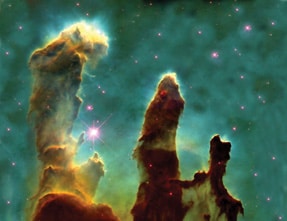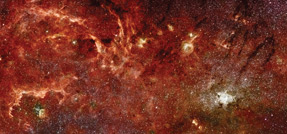Life
What We See, Isn't

Don't trust what you see in the heavens.
|
We believe what we see, but astronomy has long taught us that our eyes deceive. What we see today might be the drama of the cosmos unfolded long ago. Past, present and future lose their meaning in the vastness of the universe.
Recently, researchers and telescopes detected the most distant object in the visible universe. While we celebrate the discovery, the fact is that this particular object likely no longer exists. So, even as we wonder how far we can see to the edge of the universe, it also invites the fundamental question, can we trust what we see?
400 years after Galileo peeped into the heavens using the first telescope, human civilization set its sights on the edge of the visible universe. The Gamma Ray Burst (GRB), named GRB 090423, is the most remote object we have ever seen in the cosmos. There are no magic machines in the foreseeable future to lead us further. This GRB, estimated to be 13.1 billion light years away, is one of the brightest stellar explosions recorded. NASA’s space telescope SWIFT spotted the event first in April 2009 and then followed it with scores of ground based telescopes. “It’s the most distant gamma-ray burst, but it’s also the most distant object in the universe overall,” says Edo Berger of the Harvard-Smithsonian Center for Astrophysics, a member of the team that observed the afterglow with the Gemini North telescope. Astronomers use something dubbed the “red shift” as a tool for determining distances in the universe. The red shift is the wavelength or frequency shift of light as it travels. This is similar to the changes in the frequency of an ambulance siren as it passes by. We perceive the declining frequency or lower pitch of sound as it travels even though the ambulance is producing it at the same frequency. Analysis of light from cosmic events, such as GRB, the most luminous event in the universe, enables researchers to measure the distance and origin of such events. Light is a messenger that conceals the details of its journey in its wavelength spectrum. It also means that if light does not reach us, there is no way of knowing what is out there in the farthest corners of the universe.
The GRB 090423 is the aftermath of the explosion from one of the early stars in the universe. Since this event occurred 13.1 billion years ago and the universe is considered to be 13.7 billion years old, this first generation star had a life span of about 630 million years – a young star by cosmic standards. It is usual for massive stars to end their life at younger ages compared to lighter stars, which survive billions of years. When mid-sized stars, such as our sun, finish their main sequence life, they end up as “white dwarfs,” a relatively quiet event. However, massive stars send the message of their demise as waves after a violent death in the form of supernovas. During this process the core of the star transforms into a highly dense neutron star sending the outer layer of stellar masses to form a nebula. A nebula serves as the feeding ground for the next generation of stars. Nebulae teach us that death and birth are cyclic in the universe rather than absolute transformations. Our solar system was once a part of a nebula created from the death of a star caused by a supernova explosion. In nature, creation-preservation-destruction are continuous cycles, without beginning or end. As the Bhagvad Gita says, “Death is as sure for that which is born, as birth is for that which is dead.”
A supernova explosion in the past created a nebula that in turn became the birthplace of our star sun and planets. Scientists believe our sun is a third generation star. Millions of years later, organic molecules formed in one of the planets to evolve to become intelligent beings – humans. In essence, all the heavier elements, such as carbon, oxygen and nitrogen that make up our body came from super nova explosions. The elements heavier than hydrogen were created in the interiors of stars and then expelled into space to be integrated into later stars. As the astronomer Carl Sagan once noted, we are made of “star stuff.” The Eagle nebula, which is 7,000 light years way from earth, is one of the most admired nebulas, thanks to the Hubble telescope, which captured this nebula in all its majesty. The Eagle nebula shows huge columns of gas and dust light years across, which are known as the “Pillars of Creation.” The pictures show that new stars are born in this stellar nursery. Astronomical calculations reveal that these pillars vanished 6,000 years ago due to a nearby supernova explosion. Yet, we will continue to see the intact pillars for another 1,000 years as the message of that destruction in the form of light has yet to reach us. Time is an illusion in which we live, along with space and is created by the movement of objects and perceptions. Time exists because we are bound to things through our senses.
Supernova explosions are celebrated events among astrophysicists because they provide a rare opportunity for researchers to study distant parts of the cosmos. Even our most sophisticated telescopes are unable to spot a star at those distances, but a supernova outshines even its mother galaxy providing an exceptional chance to look at it. The stellar explosions more powerful than supernova are known as hypernovas. These rare events are capable of sterilizing life in their cosmic neighborhood. In a galaxy, such as our own, the Milky Way, these events occur rarely – once every 100,000 years. Given the billions of galaxies spanning the universe, however, it is a common event in the universe. If the supernova explosion leads to neutron stars, scientists think that hypernovas might create something more bizarre – a black hole. The GRBs are said to be the “birth cry” of black holes from the farthest corners of the universe. When we look at the sun, in fact we are seeing the sun as it existed 8 minutes ago – the time light takes (at a speed of 186,000 miles per second) to travel the 93 million miles between sun and earth. Even if the sun disappears in a cosmic event, we will continue to see the non-existing sun for 8 minutes! We perceive the past of the sun as our present sun. By the same reasoning, what we are seeing of the GRB is an event that took place 13.1 billion years ago. This GRB and the resulting nebula must be long gone, but the earthlings see it now as the “messenger light” from that occurrence just reached us in this corner of the Milky Way galaxy. We are looking at this GRB today and seeing the yesterdays!
Under the Big Bang theory, cosmologists believe the universe is expanding since its birth 13.7 billion years ago. When the waves originating from this hypernova began their journey, the universe was much smaller than its current size. As the waves propagated throughout the universe they had to travel greater distance as the departing galaxies created new space between them. The gamma rays encountered this new space as extra distance on their voyage. Thus, the successor of this event, if it exists, must be much farther than 13.1 billion light years. Probably, we will never know about it as its distance to our galaxy has increased so much that the light or any electromagnetic radiations will never reach us. The visible universe represents the space we can conceive in the sense that radiation from there will reach us. There must be much more to explore beyond the visible universe, but we have no means of knowing. As the universe continues its expansion, eventually our Milky Way galaxy will be left alone in the universe with all the others departed to farther reaches. In the absence of any information from other galaxies, the mortals on this galaxy might assume that their universe is their own galaxy. So how far can we see? The puzzling answer is around 13 billion light years. Our best telescopes can see a few million years after the origin of the universe. But we cannot see anything before the point when light emerged out of the baby universe. Asking the question “how far can we see” is actually the same as inquiring, “how far back in time can we see?” The expanding universe imposes a limit on our view and so we will not see anything beyond 13 billion years ago. And when we see it, unfortunately it will not be there any more! In the Gita, Krishna tells Arjuna, “All created beings are unmanifest in their beginning, manifest in their interim state, and unmanifest again when they are annihilated. So what need is there for lamentation?” |





